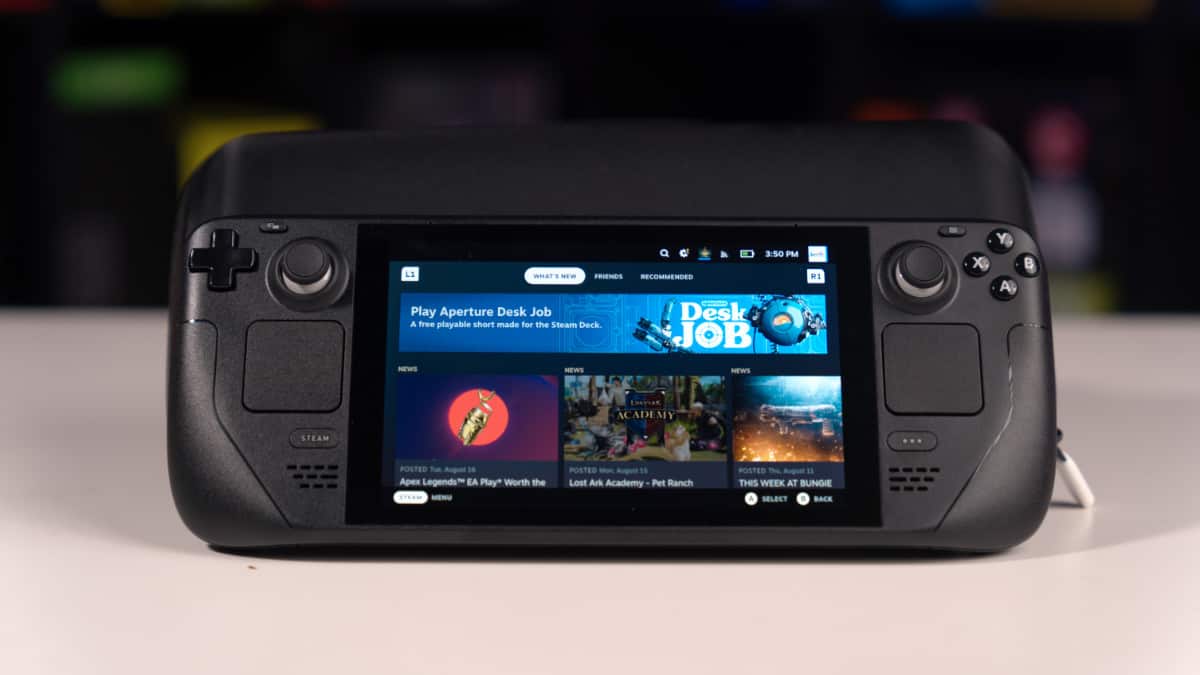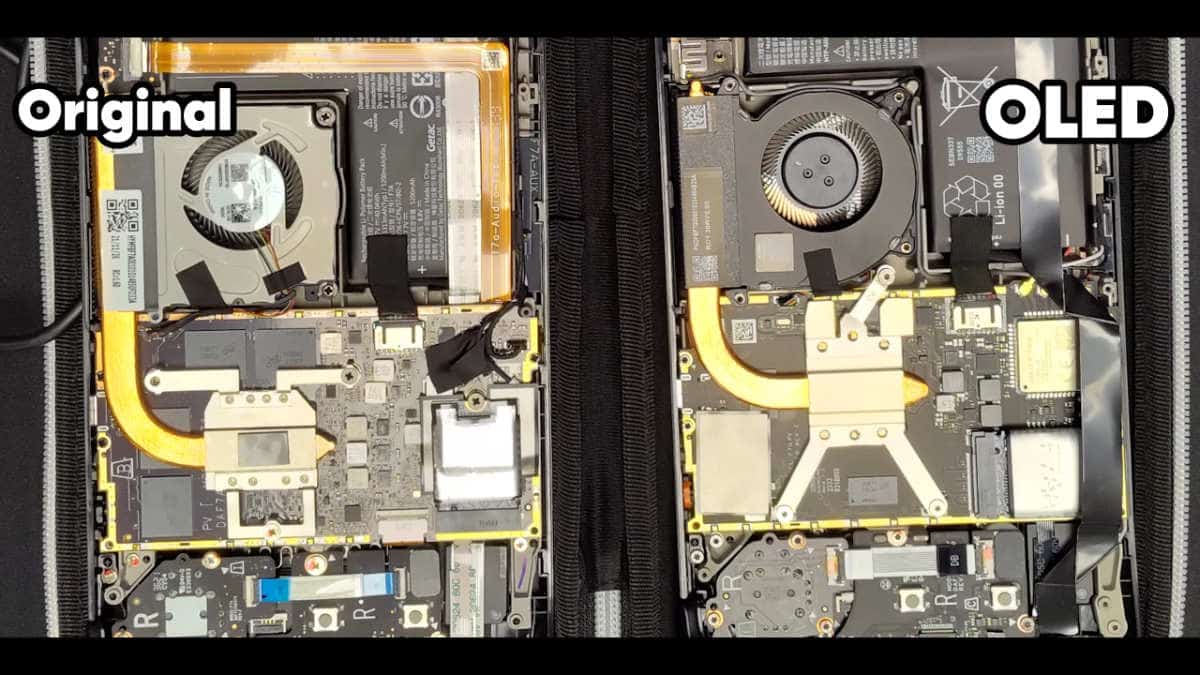OLED Steam Deck vs original Steam Deck – what’s changed?
What has Valve changed in the new version?

WePC is reader-supported. When you buy through links on our site, we may earn an affiliate commission. Prices subject to change. Learn more
Valve’s done a hugely unusual thing, it’s worked with plenty of sites and influencers to announce its new handheld. Well, not all new, it’s mostly the same but it’s gotten some upgrades so the name is actually staying similar, and we see what’s changed by comparing the OLED Steam Deck vs original Steam Deck.
The Steam Deck OLED was announced on the 9th of November 2023, over two years after the original that was shown off in July 2021. Even though it had been reported that the new version might not be coming for years, that doesn’t include a refresh and that’s where we get the new version with an OLED screen, so let’s see what’s changed.
OLED vs original Steam Deck specifications
Now with the new version of the Steam Deck, you might expect big changes, but there are only a few adjustments. The key thing is that the dimensions are mostly staying the same, the external that is, and means that your Steam Deck accessories and cases should be compatible and still work with the new one. However, with internals adjusting the likes of joysticks and batteries are being changed so that may make it harder to change out.
| Steam Deck OLED | Steam Deck original | |
|---|---|---|
| Processor | AMD APU | AMD APU |
| Node | 6nm | 7nm |
| CPU | Zen2 | Zen2 |
| GPU | RDNA2 | RDNA2 |
| CPU core count | 4 cores / 8 threads | 4 cores / 8 threads |
| CPU frequency | 2.4-3.5GHz 448GFLOPS FP32 | 2.4-3.5GHz 448GFLOPS FP32 |
| Compute units | 8 | 8 |
| GPU frequency | 1.0-1.6GHz 1.6 TFLOPS FP32 | 1.0-1.6GHz 1.6 TFLOPS FP32 |
| APU power | 4-15W | 4-15W |
| Memory capacity | 16GB | 16GB |
| Memory spec | LPDDR5 6400 MT/s 4x 32-bit | LPDDR5 5500 MT/s 4x 32-bit |
| Storage | 512GB NVMe SSD 1TB NVMe SSD MicroSD slot | 64GB eMMC 256GB NVME SSD 512GB NVMe SSD MicroSD slot |
| Screen size | 7.4″ | 7″ |
| Screen resolution | 1280 x 800 HDR OLED | 1280 x 800 IPS LCD |
| Max brightness | 1000 nits peak (HDR) 600 nits (SDR) | 400 nits typical |
| Refresh rate | 90Hz | 60Hz |
| Additional features | >1,000,000:1 contrast 110% P3 color gamut <0.1ms Response time Dual ambient light sensor ALS | Ambient light sensor |
| Battery | 50Whr (2-12hrs) | 40Whr (2-8hrs) |
| WiFi spec | 6E | 5 |
What does the OLED Steam Deck change?
The primary change of course is the new Steam Deck is the OLED display. But that isn’t the only difference that has caused in the handheld. Gamers Nexus and LTT both detail and look at the changes of what it has to offer. In particular, the OLED Steam Deck shrinks the depth of the screen so it can change the insides.
The APU inside is also getting a change. Shrinking nodes, without changing the processing power means it is a lot more efficient. It doesn’t produce as much heat and so can be cooled better with the cooling inside of it. Plus it allows the battery to be increased too, jumping up to 50Whr, adding up to 4 hours of game time. This also comes from the benefits of the OLED screen which is more efficient.
With increases in speed as well for the low profile DDR5 memory, and in particular, the refresh rate has jumped up by 30Hz too. Although the resolution stays the same, the screen size has in fact increased. by just 0.4 inches Valve has achieved that by shrinking the bezels so you can enjoy even more immersive gameplay.

The improved look also comes with changes to the inside, even small things like taking it apart. The screws now go into metal channels so you don’t risk ruining it by taking it apart and more similar lengths and types of them are used too. The bumpers, touchpads, and joysticks are also getting a change to the type and how they are positioned. Changing alternates even though they might not have gone for hall effect sensors.
Is the OLED Steam Deck better in performance and thermals?
As we’ve seen in the Linus Tech Tips video, the OLED Steam Deck does in fact improve in performance even if without any proper upgrades to processing. But the culmination of memory speed, thermals, and cooling does mean it increases the framerates.
It was not a drastic change but just a few FPS across the board including minimum and averages that is key. It will still vary based on the game, but constant updates to the handheld do provide changes and improvements that you can take advantage of.
Especially as LTT also shows the kind of temperatures the device reached. With an average dropping by about 8°C that makes all the difference when getting performance and having to hold it.
Steam Deck pricing
Now with the OLED, the pricing has also changed. Along with a Limited Edition clear option (US and Canada only) the pricing of the whole lineup has changed. Since the older LCDs are getting replaced, the 64GB and 512GB are getting cheaper while stocks last, while the 256GB is getting a price drop. Here are the new prices for the Steam Deck.
- Steam Deck 256GB LCD – $399/£349
- Steam Deck 512GB OLED – $549/£479
- Steam Deck 1TB OLED – $649/£569
- (While lasts) Steam Deck 64GB LCD – $349/£309
- (While lasts) Steam Deck 512GB LCD – $449/£389

Final word
Now if you’ve just bought a Steam Deck original, you might want to consider Steam’s Hardware return policy. You have two weeks to cancel your order and that’s not only due to the upgrades because the other options are getting cheaper. Now the lineup is changing as the Steam Deck OLED 512GB and 1TB are the top two options, whilst the budget choice is only the 256GB LCD.
But overall the change is a great one, much like the Switch OLED launching, it does provide a great new value to the handheld and makes it the best choice to go for. Especially with the great new 1TB SSD in it and all the improvements it provides.





